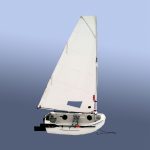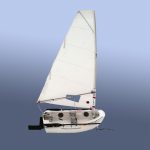Portland Pudgy Sailing Dinghy
“So far, the Pudgy [sailing dinghy] seems exceptionally stable, even in strong winds. It’s drier than such a tiny boat has any right to be…” The Great Rig Experiment, Small Craft Advisor, Larry Brown, Jan/Feb 2014
General Information about the Portland Pudgy Sailing Dinghy
The sail kit makes your Portland Pudgy a fun, safe sailing dinghy. It also makes it a dynamic self-rescue boat. For answers to frequently asked questions about the Portland Pudgy sailing dinghy, click here.
The Portland Pudgy was designed as a dynamic lifeboat for blue water sailors, that can be sailed to safety. The resulting stability and buoyancy designed into the Portland Pudgy also make it safe and sea-friendly as a recreational sailing dinghy. It’s a serious self-rescue boat and at the same time a great sailing dinghy for kids and beginning sailors.
The Pudgy takes surprisingly rugged sea and wind for a boat its size. The Pudgy is stable and difficult to capsize, but if it does, it’s very easy to right, and it comes up dry. No need to wait for rescue (as with some recreational sailing dinghies, such as the Opti)!
Gaff Rig or Square Head Rig
The Portland Pudgy now offers two sail kit configurations, gaff and square head. The sail area of the square head rig is 54.4 square feet. The sail area of the gaff rig is 51.2 square feet. If you already have the gaff rig with the telescoping boom and mast, all you need for the new square head rig is the sail and a straight mast extension instead of the gaff. All the other rigging is the same. The Portland Pudgy’s new square head rig points very well and is better in light air (see video). This is because the top of the sail gets more wind and there is more roach (i.e. more material extending from the top of the mast to the aft of the boom).
The original gaff rig is even more stable than the square head. This is because the gaff will spill out the wind when broached. We’ve sailed it in 20-25 knot winds and even when broached, it didn’t capsize. “I have been impressed with the sailing ability of the boat, especially in heavy winds… I haven’t yet found the winds where capsize seems possible!” Bill K., Sausalito, CA More testimonials.
Leg-o-mutton rig. Either type of sail (gaff or square-head) can be configured as a leg-o-mutton rig. In this configuration, the boom is set higher on the mast, but the tack of the sail is held in place with a downhaul, so the sail area is undiminished. This is a safety feature (harder to get hit on the head with the boom).
Self-Contained Sailing Dinghy: Stowing the Sail Kit
Like all of the other optional equipment, the sail kit stows neatly inside the double walls of the hull. The mast telescopes down, the gaff or mast extension folds down next to it, and the sail is furled around it, to form a package that fits into the sail bag and stows through the sailing dinghy’s transom hatch. The rudder and standard leeboards stow under the stern seat. The longer performance leeboards stow under the middle seat. There’s plenty more room for the oars (which pull apart to stow) and other accessories, equipment, and provisions. For detailed information, see Owner’s Manual.




